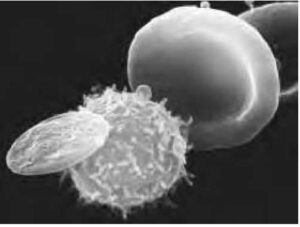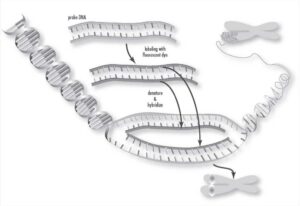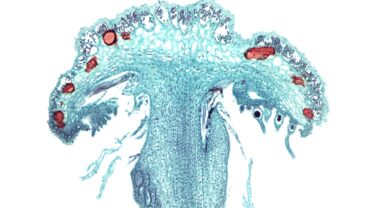Blood-brain barrier
blood-brain barrier (BBB) The blood-brain barrier is a collection of cells that press together to block many substances from entering the brain. While allowing others to pass. it is a specialized arrangement of brain capillaries that restricts the passage of most substances into the brain, thereby preventing dramatic fluctuations in the brain’s environment. It maintains the chemical environment for neuron functions and protects the brain from the entry of foreign and harmful substances. Blood-brain barrier allows substances in the brain such as glucose, certain ions, and oxygen and others to enter, while unwanted ones are carried out by the endothelial cells. It is a defensive system to protect the central nervous system.
What is little understood is how the blood-brain barrier is regulated, In fact why certain diseases are able to manipulate and pass through the barrier.
| Here scanning electron micrograph (SEM) showing three types of cells found in human blood. At right is a red blood cell (erythrocyte), a biconcave disc that transports oxygen around the body. A white blood cell (center) is roughly spherical with microvilli projecting from its surface. Different types of white cells are active in the body’s immune response to infection. The waferlike cell at left is a blood platelet, which functions to control clotting and thus prevents bleeding from damaged vessels. Each cubic millimeter of blood contains approximately 5 million red cells, 7,000 white cells, and 250,000 platelets. Magnification: x3,850 at 35-mm size, x27,000 at 8 x 10-in. size. (Courtesy © NIBSC/Photo Researchers, Inc.) |
Evidence:
There is evidence that multiple sclerosis attacks occur during breakdowns of the blood-brain barrier. A study in rats showed that flavinoids, such as those found in blueberries and grape seeds among others, can inhibit blood-brain barrier breakdown under conditions that normally lead to such breakdown.
Moreover Researchers at the University of Maryland School of Medicine in Baltimore have identified a receptor in the human brain that regulates the interface between the bloodstream and the blood-brain barrier. And could lead to a new understanding of this nearly impenetrable barrier and to treatment of diseases that affect the brain. They found that two proteins, zonulin and zot, unlock the cell barrier in the intestine. And attach themselves to receptors in the intestine to open the junctions between the cells. Allow substances to be absorbed. The new research indicates that zonulin and zot also react with similar receptors in the brain. Suggesting that it may become feasible to develop a new generation of drugs able to cross the blood-brain barrier.
| The last Fluorescence in situ hybridization is a process that vividly paints chromosomes or portions of chromosomes with fluorescent molecules. This technique is useful for identifying chromosomal abnormalities and gene mapping. (Courtesy of Darryl Leja, NHGRI, National Institutes of Health) |






